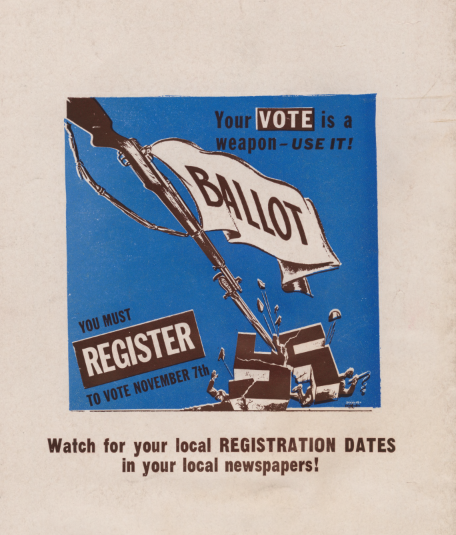International Workers' Order (IWO) and Jewish People's Fraternal Order (JPFO)
Some texts use the term 'Negro' to refer to Black people in the context of the concerted efforts made primarily in the 1920s-1940s to fight racial discrimination. While the term 'Negro' might be read as pejorative today, the term was then used in a positive regard, including by Black leftists.
About this collection
This digital collection contains a subset of materials from the Kheel Center's IWO Records (#5276). Approximately ten percent of the physical collection has been digitized. Materials include memos, minutes, correspondence, convention proceedings, flyers and other ephemera, Jubilee (anniversary) journals, educational materials, political pamphlets and the occasional magazine. The materials are primarily typed text (English or Yiddish) on paper with some handwritten materials in Yiddish. The collection also includes flyers, concert programs, and coupons. There are a few radiograms (from the U.S.S.R. or elsewhere) and telegrams, as well as photos. The bound volumes of newsletters as well as other more graphic documents such as pamphlets or songbooks are associated with cultural programs and/or projects. Of note is a rare 1941 poetry anthology published in Moscow by the Jewish Anti-Fascist Committee as well as autographed letters from Marc Chagall.
This digital collection contains materials selected by Elissa Sampson, Research Associate, Jewish Studies Program and Jonathan Boyarin, Mann Professor of Modern Jewish Studies, in support of an online teaching and research tool for fields such as American history, labor, left, immigration and ethnic studies, Black history, the Cold War and Jewish studies. This collection addresses issues and responses arising from the transformations of Jewish and other identities in the middle of the twentieth century under the pressures of immigration, revolutionism, World War II, and the Cold War. The creative cultural and political responses of IWO Black organizers, allies and members to fighting segregation and violence are integral to the IWO's understanding of class, race and ethnicity. The IWO tied together the fight against "Jim Crow," antisemitism and anti-immigrant sentiment. Its culture work prioritized the participation of musicians and other artists in radical politics. Overt ideological answers are seen throughout, not least in the history of splits and reconfigurations in United States radical politics during the first half of the twentieth century.
Historical context
The IWO was founded in 1930 as an immigrant fraternal order that provided high-quality, low-cost health and burial insurance and other benefits for members. The origins of the IWO / JPFO arose from a decade of splits (1920-1930) concerning the U.S.S.R., the Bolshevik Revolution and Communism that consumed the Jewish Federation of Socialists and the Arbeter Ring [Workmen's Circle] groups associated with Eugene V. Debs' Socialist Party. For those familiar with Yiddish-speaking immigrants, this grouping was often referred to as Di Linke or the Left. By 1932, the IWO expanded to become the sole U.S. interracial and interethnic fraternal order, eventually encompassing 16 "national" sections. While the vast majority of the IWO's members— approximately 200,000 at its peak right after World War II—did not belong to the Communist Party of the United States of America, the IWO's politics and leadership were largely aligned with those of the Party. The IWO was legally disbanded in 1954 due to the Cold War "Red Scare." This closure followed on a famous and unprecedented court case, in connection with which the organization's insurance funds and records were seized by New York State's Insurance Department.
The JPFO—approximately 50,000 members at its height—was the largest of the many "national" or "language" sections of the IWO. The Kheel Center's IWO Records (#5276) directly record the activities of the JPFO, in English as well as Yiddish. These documents provide a rare window into the politics and culture of the Yiddish-speaking immigrant Left during World War II. They contain the seeds of a fascinating history of competing and complementary loyalties and priorities: to the Soviet Union and the international left-wing movement; to the United States; and to the Jewish people and the propagation of secular Yiddish culture.
During the Popular Front and most especially World War II, many IWO "fellow travelers" trod partially or fully on the same path as Party members. During these years, as knowledge of Nazi policies and atrocities increased, aligning with policies that supported Stalin's U.S.S.R. could be viewed as tantamount to fighting Hitler's Germany. Although they typically kept their distance from Stalinist politics, as seen in these archives notable fellow travelers included Marc Chagall, Albert Einstein, Sholem Asch, Langston Hughes, William Gropper, Howard Da Silva, and Vito Marcantonio. Figures such as Pete Seeger, Paul Robeson, Earl Robinson, and Howard Fast, were more directly connected to the Party.
Using the collection
The following acronyms are used throughout the collection: International Workers Order (IWO) and Jewish People's Fraternal Order (JPFO).
For more information about the collection, contact the Kheel Center for Labor-Management Documentation and Archives at kheelref@cornell.edu.
Sets
More information
- Collection steward
- Steven Calco, Interim Assistant Director of the Kheel Center
- Metadata creation
- Elissa Sampson, Research Associate, Jewish Studies Program; Jonathan Boyarin, Mann Professor of Modern Jewish Studies; Jazz Burns, Visual resources metadata librarian; Steven Folsom, Metadata Librarian; and David Forman, Translator
- Funding
- Grant Program for Digital Collections in Arts and Sciences, awarded in 2016 to Jonathan Boyarin, Anthropology, Near Eastern Studies, Jewish Studies; Elissa Sampson, Jewish Studies; additional funding from Saltzman Schwartz family, Milton Leitenberg, and Maddy Simon.
- Credits
- This collection overview was prepared by Katie Keegan, Reference Assistant, and last updated in May 2025.
- Collection sources
- Exhibits featuring items from this collection

